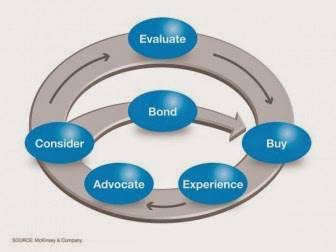Why Customers Buy (It's Pretty Simple, Actually)

We recently did some work for a brand that had very high awareness but low consideration in the e-commerce space. Their goal was to get more buyers to consider and evaluate their brand when purchasing. The first step involved developing a better understanding of the "consumer decision journey."
McKinsey & Co introduced the concept of the consumer decision journey in 2009, andpresent it today as shown here:

The graphic shows the key stages of the consumer decision journey:
- Consider: What brands/products do consumers have in mind as they contemplate a purchase?
- Evaluate: Consumers gather information to narrow their choices.
- Buy: Consumers decide on a brand and buy it.
- Post-purchase experience: Consumers reflect on the buying experience, creating expectations/considerations that will inform a subsequent purchase.
- Advocate: Consumers tell others about the product or service they bought.
- Bond: Consumers skip or short-circuit the evaluation process and decide not to switch brands.
Our client was not winning in the consideration or evaluation stages. At most they were winning at the moment of purchase, as their web site and SEO efforts attracted buyers doing a final check of alternatives before purchasing. The client wanted to address these gaps while remaining true to their core (and highly profitable) operating model. After some initial analysis of the business, we formed a couple of hypotheses:
- When they lost consumers at two key stages of the journey--"evaluate" and "buy"--they were also losing them on future consideration opportunities.
- Consumers that had a few successful transactions were highly likely to find the brand habit-forming and "bond" with the brand.
We decided, therefore, to focus on winning during evaluation and at the moment of purchase, which in turn would drive future consideration. We scoped out four key areas to explore that we felt would improve the "evaluate" and "buy" stages in the short term and drive consideration in the long term.
- Ease of use: Can we simplify the shopping experience by minimizing the number of clicks required to complete a transaction?
- Breadth of offering: Can we partner with other manufacturers to populate important categories that we were currently underserving, or could we create "destination" brands that were exclusive to our site?
- Decision-making support: Can we enlist the community to help their peers find and choose the right products? Would a rewards program for assistance be a good incentive?
- Connection: Can we add live chat or other features to humanize the shopping experience and help the consumer to feel more connected to the brand?





